| 1 | Ornate reef snake |
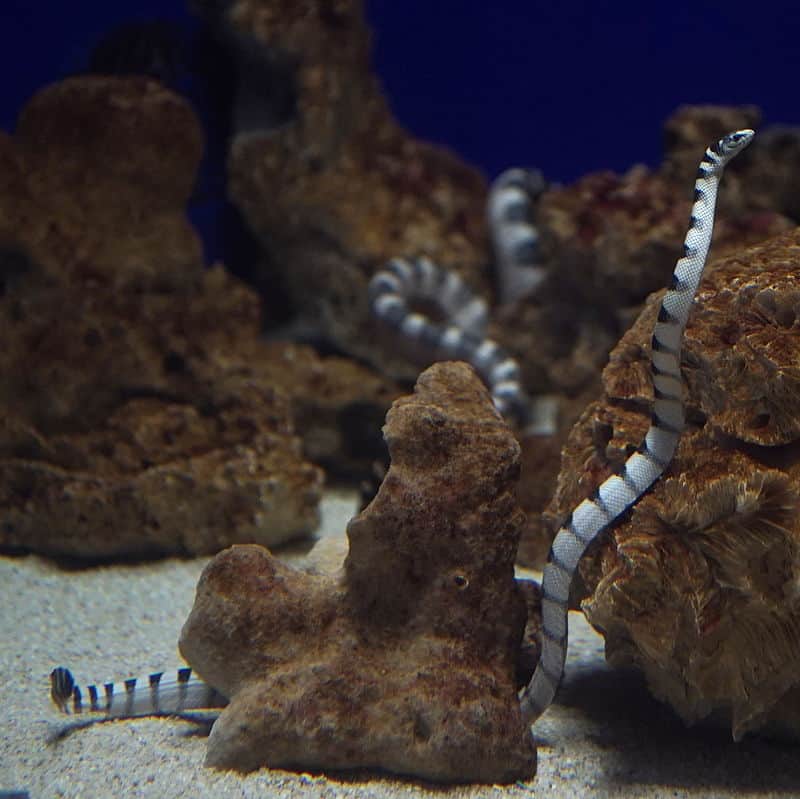
The ornate reef snake (Hydrophis ornatus) is one of the most successful sea snakes, as it can inhabit muddy estuaries and shallow ocean floors all the same. Coral reefs are another habitat, which they lurk in to ambush catfish, cardinalfish and goatfish swimming freely in the open water nearby.
The spotted seasnake isn’t endangered in the slightest. It’s found in over 20 countries from Oman and Thailand, to Australia and Fiji. It’s at home in shallow waters and during low tide, can sometimes be spotted resting on the top of exposed coral reefs. They particularly like to hunt in sandy areas directly adjacent to coral reefs.
Scuba divers beware – hyrophis ornatus has a strong venom and at least one human death is known from its bite. This reef snake is active during both day and night, so there’s a decent chance of seeing them. Ornate reef snakes vary from 85cm to 115cm long. They always have bulky black patterns on their bodies, but the colour beneath varies from white to olive-yellow.
| 2 | Dubois’ sea snake |

This is a darker coral snake, with purplish-brown scales, each bordered by faint white lines. It mostly lives in Australian waters, straying to Papua New Guinea. The Dubois’ sea snake (Aipysurus duboisii) is a staple of shallow coral reefs surrounded by sand and seagrass. You can find them in Great Barrier Reef, Seringapatam Reef, Scott Reef, and Ashmore Reef, although they haven’t been seen in the latter since 1994.
Aipysurus duboisii isn’t a pursuing snake. It prefers to lurk in coral reefs and capture fish by cornering them in crevices. But it sometimes ventures out and crawls along the ocean floor, and can descend to 50 meters when breeding. Dubois’ sea snake is also known as the reef shallows snake.
It’s another reef snake with strong venom, extremely lethal against mice in a lab (the only time the two species will have met), and with an LD50 rating of 0.044mg. Dubois’ sea snake isn’t notoriously aggressive, but will bite if cornered, even if you weren’t intentionally cornering them, swimming along and minding your own business. At up to 1.2 meters long, they have the leverage to get in your face.
| 3 | Ijima’s sea snake |
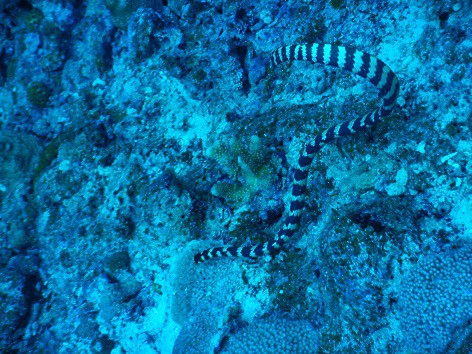
This reef snake has one of the narrowest niches in the whole snake kingdom. It lives solely off coral reef eggs, allowing fish nor eels into its diet. For this they have many unique characteristics. Their nose has a spike which they move from side to side to dislodge eggs from the reef bed. Their jawbone is differently structured, to allow them to suck eggs free. Their fangs are weakened as they no longer need them.
At 85cm, Ijima’s sea snake (Emydocephalus ijimae) is a short reef snake, and their body patterns consist of alternating black and pale-yellow stripes. They’re a reef snake of eastern Asia, living off the coast of Japan, east China, Taiwan, Indonesia and the Phillipines. They produce very few young, just 2 snake-lets per litter (live rather than eggs).
Emydocephalus ijimae’s whole world consists of the colourful chasms and twisting turns of coral reefs. They’re still relatively unresearched, although it’s believed that they fulfil an important ecological role, probably keeping certain fish species under control (a bit like Alaskan bears and salmon).
| 4 | Stoke’s sea snake |
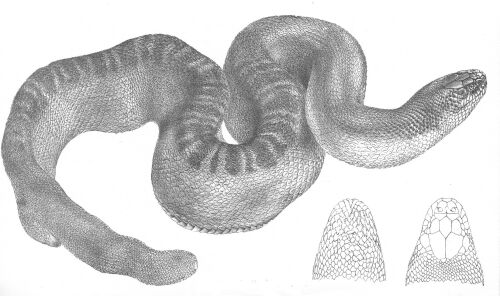
Stokes’s sea snake (Hydrophis stokesii) is a very common underwater serpent, with flexible habitats. They like ocean floors and shallow sandy flats, but also coral reefs, including Great Barrier Reef and Ashmore. They’re an extreme snake in many ways, beginning with powerful swimming skills, which allow them to seize slow-moving fish. One of their favourite species is the banded frogfish, which they hunt down in coral reef crevices.
They also look strange, with a massive transformation from juvenile to adult. Younglings look sleeker and have alternating patterns of black and creamy yellow. By adulthood, they’ve mutated into a thick and leathery creature with only very faint patterns remaining, and dull-brown grey mostly dominating. It’s weird enough that some scientists place it in its own family of Astrotia.
They’ve never caused a death, but have the longest fangs of any sea snake, long enough to pierce a black wetsuit (maybe yours…). They can be randomly aggressive to beach-goers and scuba divers, flying in for no reason. Danger lurks around every corner in coral reefs.
| 5 | Olive sea snake |

The ruler of Great Barrier Reef. Olive sea snakes (aipysurus laevis) are an extremely common snake. While inexplicably lacking in certain reefs, they can reach levels of 0.70 to 0.86 per metre in others.
Olive sea snakes are 1.5 meters in length and have a weird tendency to chase exploring scuba divers and wrap around their legs. They’re extremely patient hunters, and choose the vertical walls of coral reefs to explore for fish. They investigate each crevice thoroughly, before moving to the next about 2 meters away, then rinse and repeating. Their venom has an LD50 rating of 0.22mg, but they rarely bite scuba divers swimming past (hugging is another story though). The only thing that sets them off is touch, which triggers sheer viciousness.
Olive sea snakes rule coral reefs, but lack a particular base. When transported to new reefs, a few miles away, olive sea snakes never tried to return home, and always settled into their new reef comfortably. Ashmore Reef, Timor Coast and Shark Bay are also hotspots for these very common snakes. Their wider territory includes New Caledonia, Loyalty Islands and Papua New Guinea.
| 6 | Flat-tail sea snake |
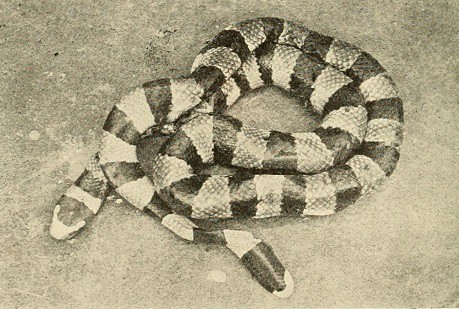
Few have heard of the tiny Pacific Island of Niue. It’s found 1500 miles northwest of New Zealand, and consists of just 17 villages. The mean temperature stays at 22-27C all year, and a rare noni fruit grows in the forests which the islanders turn into noni juice. Most importantly, the entire island is surrounded by coral reefs, except for the central western area adjacent to the capital of Aluti. The island itself is a raised coral atoll.
This Niue reef is the sole habitat for the Katuali, or flat-tail sea snake (Laticauda schistorhyncha). The snake has black and white patterns, and a very flat body used for paddling.
Being so rare, almost nothing is known of is life, except that it favours coral reefs. It’s closely related to the common black-banded sea krait, but is a shorter dwarf form, at 1 meter versus 1.5. It’s a colony that sought refuge there and became isolated, slowly diverging over the ages. Studies have scoured the surrounding oceans for more colonies of flat-tail sea snakes over the years, but all have come up short. Niue is its sole domain.
| 7 | Blue-lipped sea krait |
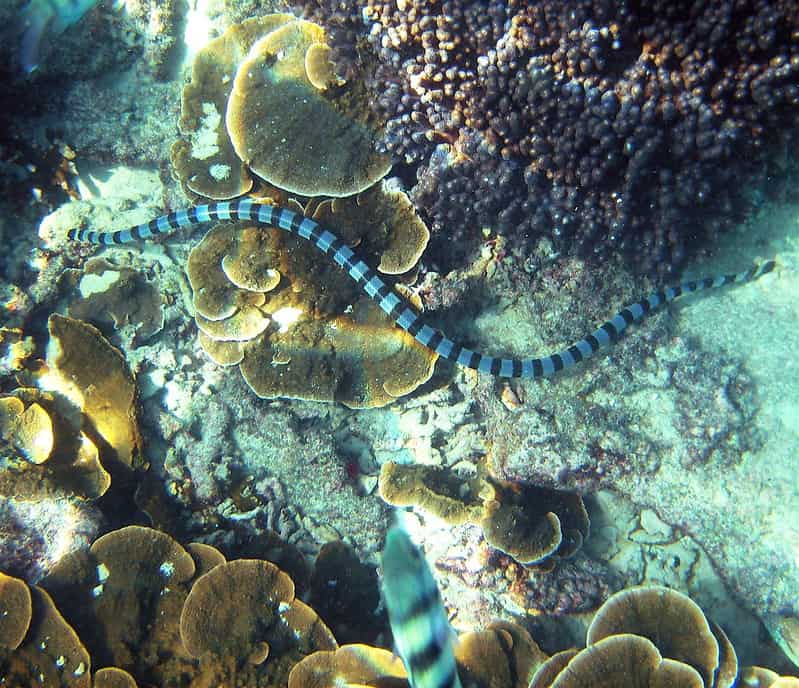
A neat and tidy snake with blue and black stripes contrasting at regular intervals. The colours of this snake make it perfectly at home in coral reefs, its main habitat. Its one of the most common reef snakes, occupying a vast range from coastal Queensland in the south to Japan in the north. It was an early discovery, first recorded in 1758.
Blue-lipped sea kraits measure 1 meter with an official record of 1.18 meters, and are a classic prowler, moving along coral reef walls diligently to find eels they can flush out. Problem is they often fight back – eels have a nasty bite and many blue-lipped sea kraits have old scars on their bodies. Laticauda laticauda use coral reefs as an underwater base, as they spend 50% of their time on land, including for digesting food. Then they return to coral reefs to hunt, mostly under cover of darkness, but sometimes in daylight.
The blue-lipped krait is an egg-layer, and stashes them in cracks in the coral rock. Eels are overwhelmingly their main food, and they hunt them using a venomous bite. The LD50 of this venom is 0.16mg, but the yield is unknown, so be careful.
| 8 | Cogger’s sea snake |
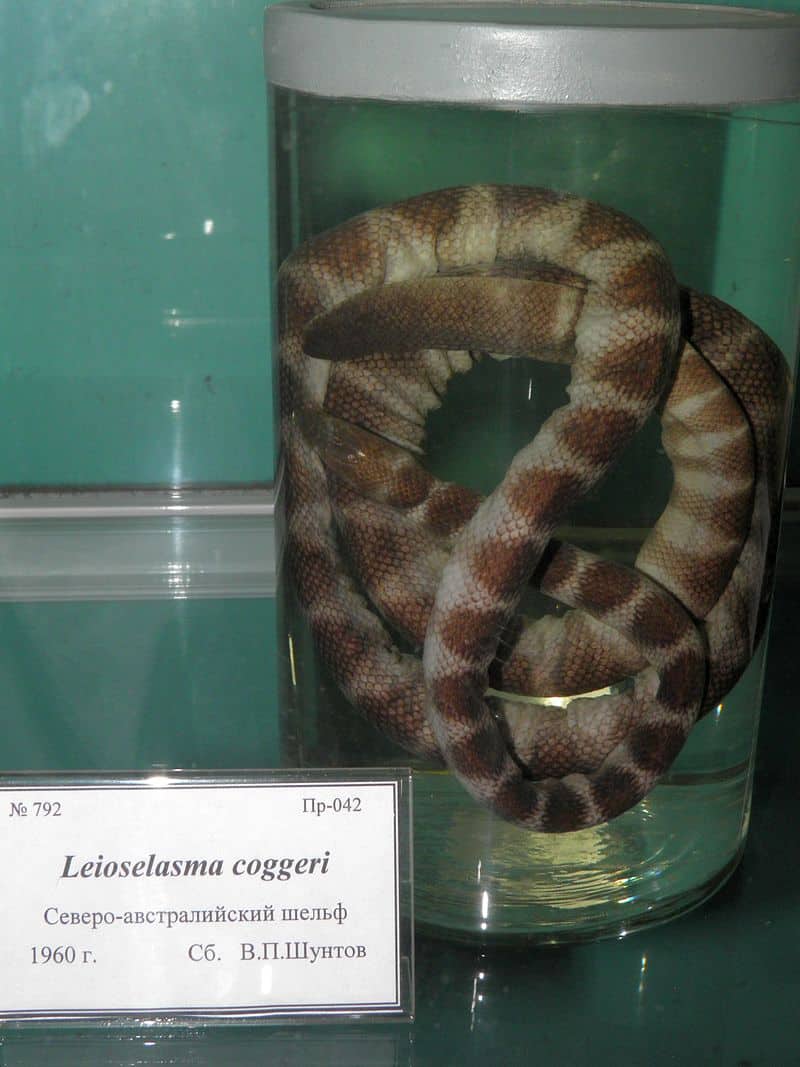
A snake of Australian waters, plus Fiji, Vanuatu, and New Caledonia. They almost certainly have more colonies, as one in the French-controlled Loyalty Islands was only discovered in 2002. Cogger’s sea snake (hydrophis coggeri) can inhabit medium depth ocean floors, but are well at home in coral reefs. They’re also found roaming seagrass beds directly adjacent to coral reefs.
This is an eel eater, specialising in conger eels and snake eels, which it snatches from their dark burrows. To help rummage around, hydrogphis coggeri has a very small head, no thicker than the neck, which sharpens into a point. This reef snake is found at lower depths than some, often 45 meters below the surface. It’s a venomous snake, but not as potent at Dubois’ sea snake, scoring 0.1-0.2mg on the LD50 scale.
You won’t find Cogger’s sea snake in Great Barrier Reef, but they’re common on the reefs of western’s Australia’s Sahul shelf, including Ashmore reef, Scott reef, and Hibernia reef. It has olive-grey scales with faint patterns as an adult, and a large flat tail for paddling, swishing water from side to side to power itself forward.
| 9 | Short-nosed sea snake |
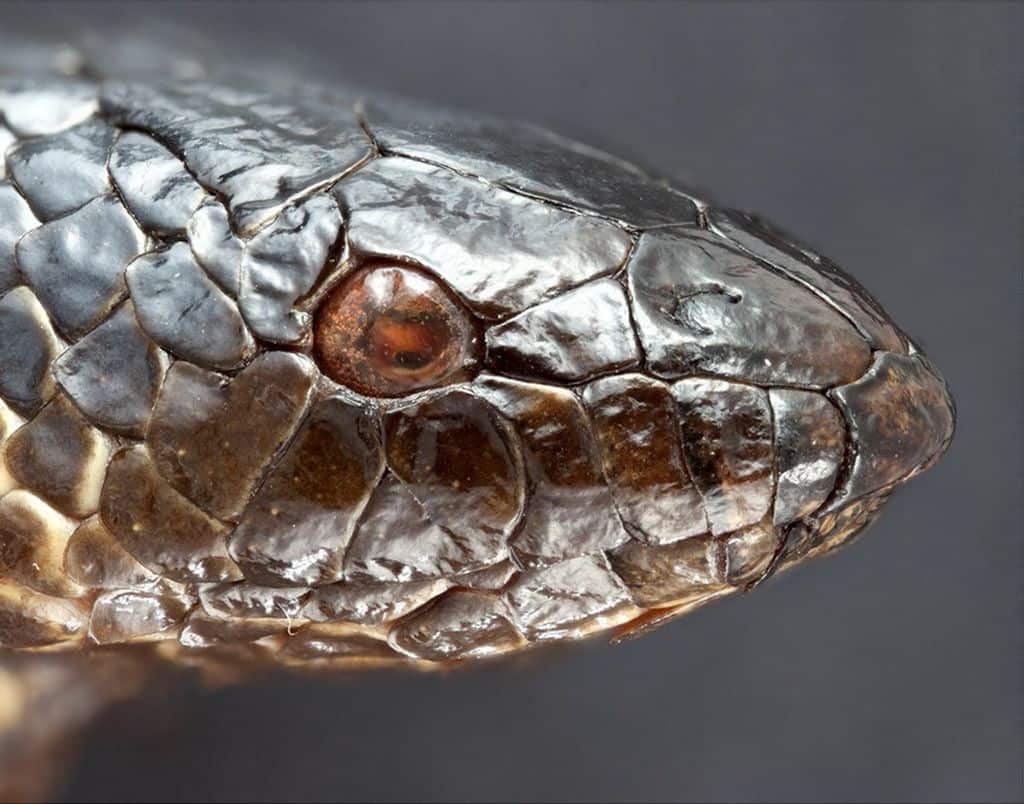
100 miles north of Australia lies Ashmore Island, and neighbouring Cartier Island. These two are scenes straight from your summer fantasy: a sandy island bordered by unbroken blue sky and sparling oceans everywhere. In the 1990s, the nearby Ashmore reef was home to the short-nosed sea snake (Aipysurus apraefrontalis). This was one of the shiest coral species, often spotted hiding beneath coral overhangs at 1-2 metres deep. They were different in how they barely stayed from the reefs at all; even one swimming to 50 metres away was rare. Like others, they prowled through colourful coral channels and flushed out fish from their holes, before biting and injecting a powerful venom. Its diet consisted of goby fish and eels.
Why are we using the past tense? Because aipysurus apraefrontalis is at severe risk of extinction. It once made up 6-14% of sea snake sightings at Ashmore reef, but completely vanished from 1998 onwards, with not one sighting. That year, a severe coral bleaching event happened at Ashmore. The reef was believed to be the species’ sole breeding grounds.
What followed was 17 years of fear and pessimism. But in 2015, hope emerged, as the short-nosed sea snake was spotted hundreds of miles away on Ningaloo reef, on Australia’s west coast. Scientists controlled their enthusiasm, speculating whether it was a different species, but in 2021, a single short-nosed sea snake was spotted at Ashmore Reef, using remotely operated underwater vehicles (ROVs). Scientists dampened the hype once again, speculating that the Ningaloo crew had been blown off course, but this reef snake may be on course for a miraculous comeback.
| 10 | Leaf-scaled sea snake |
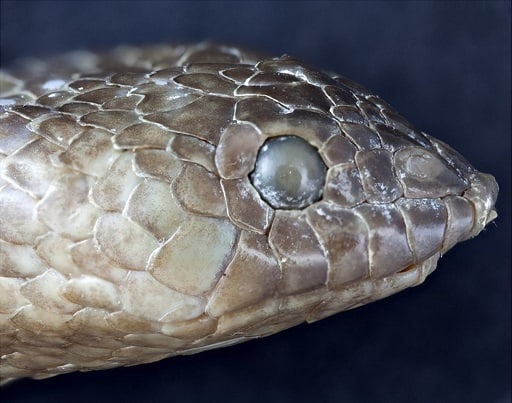
An extremely similar story happened with the leaf-scaled sea snake (aipysurus foliosquama). It was Ashmore’s signature snake, once estimated at 6600 in population. It stuck to the shallow areas of the reef, rarely descending below 10 meters. They were such a part of the reef ecosystem that barnacles would grow on their scales. It was a fish eater, particularly the threespot wrasse, which it flushed out of dark holes by poking its head all the way in (with a small head to make it easier). Leaf-scaled sea snakes measure 80cm vs the 60cm of Aipysurus apraefrontalis. As the pictures show, they were very different species despite their identical habitats and shared aipysurus family.
Then the dark turn happened, disappearing from Ashmore reef at almost the same time as its neighbour. Despite searches being 5 times more intensive than the 90s, none were spotted from 2001 onwards. Leaf-scaled sea snakes still haven’t reappeared at Ashmore Reef, but in 2015, an entirely new population was found in the seagrass beds of Shark Bay, western Australia, 1100 miles away. In 2010, a single leaf-scaled sea snake was grabbed near Barrow Island, in Australia’s far north. Yet another lone snake turned up in Port Hedland.
The big cause of optimism is that sea snakes are one of the least researched groups of all. There’s so many minor, less famous reefs and coasts where they could be lurking. Either way, these are the two rarest coral reef snakes in the world.
